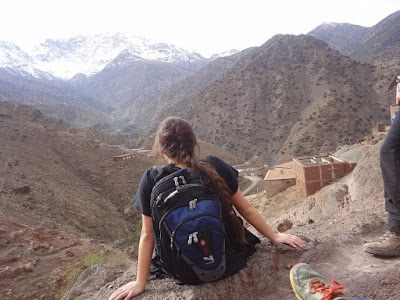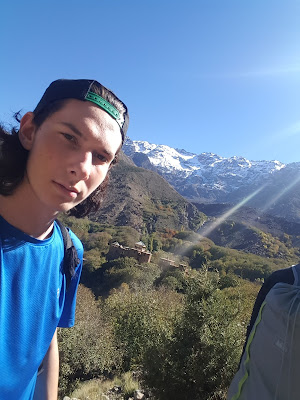Countless thoughts raced through my mind as I received text after text from my friends expressing their concern for their lives. With the election on the back of my mind, a shadow of helplessness followed as we landed in Marrakech. But I was able to forget about the election for awhile as we dove straight into a new world: the COP 22 conference. We went from little high school students who were only dipping their feet in the water at the shore to what felt like adults drowning in the middle of the Atlantic.
 |
| African women representing their countries through traditional clothing. |
There were African women drenched with their country’s culture through colorful patterned dresses and head coverings. There were Indian men walking with the pride of their country's traditional clothing. Witnessing representatives of these regions and countries- most not sharing the same languages or cultures- coming together to fight the global challenge of climate change was a life changing experience. During our week here I have had the opportunity to experience the cultural similarities of two countries in particular - Peru and Morocco. Two commonalities between between these two countries stand out - language and racism - and they are both an opportunity and challenge in effectively addressing climate change.
 |
SES COP22 delegates posed with students from the American School of Marrakech
(Right-Left: Isabel, Rey, Daniel, Gabriel, and Karim). |
One observable cultural similarity Peru and Morocco share is the responsibility citizens feel to know more than one language. In Morocco, students learn the official country language of Arabic. But they are also expected to learn French, and English. In Peru, the language barriers are usually separated by the division of areas: the highlands, the Amazonian villages, and the city. Their languages differ from Castellano (a form of Spanish), Quchua, and Aimara. These languages are what tie the differing cultures together. I have been surprised by how many languages these cultures had embedded within them, and have at times felt inferior at the COP because of how few languages I knew.
When we first arrived at COP I felt incredibly small and I didn’t know quite where to begin. But when I participated in an arts and culture discussion on racism I started to feel like I knew what I was doing. We were told to talk about how racism occurred in our communities, how it affected us, and how it drew a dividing line that would affect the way we combat climate change. The conversation I had was with a middle aged Moroccan man who explained the racism that exists between people in mountain villages and people in the city.
 |
| Picture from atop the Atlas Mountains of several villages. |
 |
| Stream at the bottom of the Atlas Mountains. |
At first I was surprised - I forgot that racism occurs everywhere. He described how much more traditional and religious the people in mountain villages were compared to the more westernized population living in the cities. During our visit to some of these mountain villages I had noticed that the women dress more conservatively, with more usage of the hijab, and some even covering their faces (with exception of their eyes). But as we travelled back into the city, the differences in how women dressed changed significantly. There was less use of the hijab and a pattern of more modern dress. When I asked a Moroccan city woman at COP why she didn't also wear the religious head dressing, she said it didn't matter whether she did or not. Women carried around designer bags such as Michael Kors and wore leggings. The Moroccan man explained that the conflict of racism lay between the reserved way women dressed and how strictly Islam is implemented within the different Moroccan cultures. But I learned that it wasn’t just Morocco that experienced racism.
 |
Project from the arts and culture section. Meant to depict the
darkness that comes with racism. |
On another occasion, a Peruvian student from Lima described the racism she has observed in her country. She explained that racism in Peru also occurred between the people who live in mountain villages and those that live in the city, but was less based on religious affiliations and more on who was more industrialized, had lighter skin, or class. She described the village people as being more tan because of how much they spend in the sun living an agricultural based lifestyle and how the darker skin tone was looked down upon by people in the city. I was glad to hear that she herself thought that people shouldn’t care how much lighter skin toned one was compared to the next, but what was most important was that they were all human, something everyone could relate to.
During my exposure to these two cultures I learned many things. First, I came to the realization that America has greatly impacted my perspective on the world. The idea that it is the land of opportunity where everyone wants to be, has led me to subconsciously believe that my country and culture are better than other countries and cultures. I have become used to to English being the only language required in the United States, with little push to learn other languages. There has been several times this past week that I wished I understood French or Arabic because it would have been so much easier to communicate. I've been reminded that language is an important part of culture, a way of connection and often times a key piece of cultural identity.
 |
| Me, sitting atop of the Atlas Mountains. |
Secondly, I was hit with the reality that racism existed outside the U.S and that it also plays a huge part in other countries. The racism that occurs creates even more division between people and affects how effective differing people can be in combating climate change. By being exposed to these new cultures, I have become more experienced and more culturally aware. I have come to realize just how much bigger the world outside the confines of the United States is.









